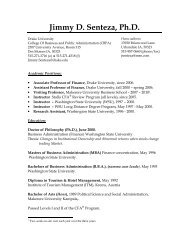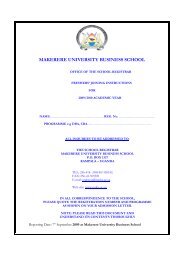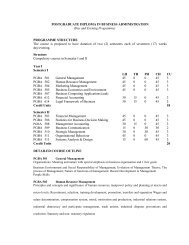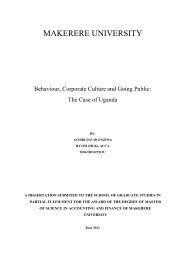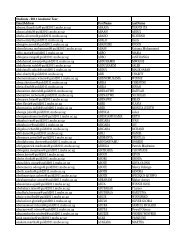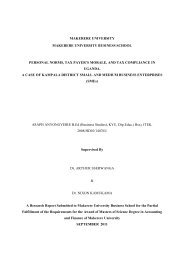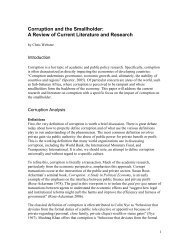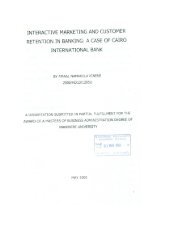13th Annual International Management Conference Proceeding
13th Annual International Management Conference Proceeding
13th Annual International Management Conference Proceeding
Create successful ePaper yourself
Turn your PDF publications into a flip-book with our unique Google optimized e-Paper software.
found to be between 20 and 30 years of age. 60% were between the age of 31 and 45 years while 23% were<br />
between the age of 46 and 61. This shows that male entrepreneurs value acquisition of more business skills<br />
than female entrepreneurs do and that entrepreneurs in the middle age group attach great importance to<br />
training and this tends to decrease towards the old age.<br />
5.0 Education<br />
On educational background, 33.3% of the respondents had completed University/College level, 13.3% had<br />
completed "A" level of education, and 43.3% had completed "O" level, while 10% of the respondents had<br />
completed standard 7. This shows that entrepreneurs with higher educational levels understand and attach<br />
great importance on the acquisition of more business skills than those with low education levels.<br />
Nature of Business<br />
The respondents were in a number of businesses namely Woodwork (30%); tailoring (10%) and<br />
dressmaking; retailing (10%); training and consultancy (10%); printing (7%) and fabrication (7%);<br />
pharmaceuticals and chemicals (7%); Juice processing (3%) and restaurants (3%). 3% were engaged laundry<br />
and dry-cleaning and 1% in saloons (Table 1).<br />
Business Type No. of Male No. of Female Total Percentage<br />
Woodwork 9 0 30%<br />
Tailoring & Dressmaking 1 2 10%<br />
Retailing 1 2 10%<br />
Training & Consultancy 0 3 10%<br />
Printing 2 0 7%<br />
Tours & Travel 1 1 7%<br />
Metal Fabrication 2 0 7%<br />
Pharmaceuticals & Chemicals 1 1 7%<br />
Juice Processing 0 1 3%<br />
Restaurants 0 1 3%<br />
Laundry & Dry-cleaning 0 1 3%<br />
Saloons 0 1 3%<br />
Total 17 13 100%<br />
Table 1: Business Ownership types based on Gender.<br />
As revealed earlier, a higher percentage of the respondents were male and this implies that they concentrated on<br />
manufacturing than retailing and services. Therefore, it is not surprising that many of the respondents were engaged in<br />
woodwork, which is male dominated.<br />
6.0 The Training<br />
The study found out that the training programmes conducted by the three institutions for business<br />
improvement and growth were relatively similar in content. The programmes covered topics such as business<br />
planning, costing and pricing, customer care, total quality management, human resources management, sales<br />
and marketing, record keeping, financial management, product design and improvement, purchasing, cost<br />
reduction and credit control. However, the one conducted by K-MAP had Time and Stress <strong>Management</strong>,<br />
which others did not have.<br />
Amongst the topics covered (Table 2), the respondents were asked to indicate the ones they found to be<br />
more relevant and appealing to their expectations. As shown in Table 2, Sales and marketing had the highest<br />
score of 50% of the total respondents. This was followed by business planning with 40%. Customer care,<br />
product design and improvement had 33% each. Total quality management had 23%, costing and pricing,<br />
record keeping and financial management had 20% each respectively. Human resource management and cost<br />
reduction and credit control had 13% each while purchasing had 3% of the total respondents.<br />
85




